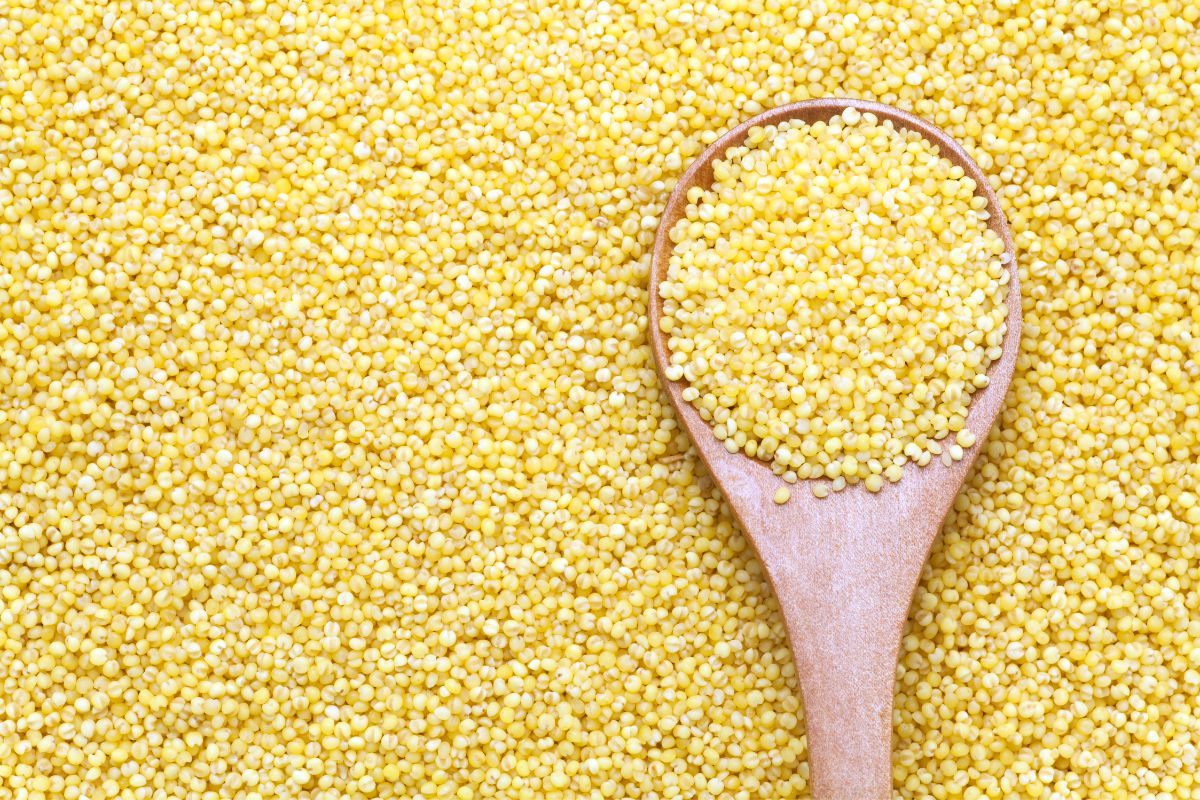Millet is a cultivated grain that has been grown in Southeast Asia and Africa for millennia and has been a staple food for countless generations.
The grain can be used to create cereal, bread, and even beer yet its health benefits are also numerous.
These range from simple organ function to controlling blood sugar levels, reducing the risk of diabetes, and healthy skin.
Eating millet is also said to improve an individual’s mood, reduce their bad cholesterol, improve their digestive health, and increase their energy levels so you may want to include it in your diet.
In this post, we will look at 11 proven health benefits of eating millet.
Healthy Skin
The consumption of millet is said to fight the effects of skin aging by those antioxidants that neutralize free radicals.
Millet can also help rejuvenate an individual’s skin cells while the presence of ubiquinone is known to reduce the appearance of wrinkles.
As millet has a high concentration of vitamin E, it is said to enhance an individual’s complexion.
That’s because the vitamin penetrates skin layers to help with wound healing, can be lubricating to the skin, and forms a protective layer against free radicals.
One study has even found that millet can have a positive effect on skin antioxidant status.
Organ Function
As millet is considered to be high in catechins, it can boost kidney and liver function. That includes quercetin which proves important as the substance helps those organs which are crucial for detoxifying the body.
While organ function may seem like a simple health benefit, as millet benefits the liver and kidneys it can have a telling effect on an individual’s health.
Improving Digestive Health
As a grain that is high in both forms of dietary fiber, soluble as well as insoluble, millet can help improve an individual’s digestive health.
That insoluble fiber is called a prebiotic so it will support the good bacteria found in the digestive system by stimulating the growth of probiotics within an individual’s microbiome.
The prebiotic content of millet will effectively add some welcome bulk to an individual’s stools to keep them regular and reduce the risk of colon cancer.
As the grain is gluten-free, it can prove very useful for those suffering from celiac disease and a gluten intolerance.
With around nine grams of fiber for every 100-gram serving of millet, consumption of the grain can help support healthy gut flora and resolve a bout of diarrhea.
Controlling Blood Sugar Levels
As a substance low in simple carbohydrates while remaining high in its concentration of complex carbohydrates, millet is a wonderful example of a low-glycemic index food.
Millet is even thought to take a longer time to digest than wholewheat flour which can help keep those hunger pangs away.
Such foods, when consumed in moderation, can go someway to control blood glucose levels which is crucial for those who suffer from diabetes.
Not only can millet help ensure that blood sugar levels do not spike after consumption of food, but in particular, as part of a controlled diet the grain can help manage an individual’s blood sugar levels more effectively.

Improving An Individual’s Mood
Millet is not only important for an individual’s physical well-being but also for their mental health.
That’s because the grain contains a fairly high concentration of tryptophan, an amino acid that, according to a study from 2014, is said to reduce the symptoms of anxiety and depression.
Reducing Risk Of Diabetes
While millet is known to help control an individual’s blood sugar levels, it can also aid those who run the risk of developing type-2 diabetes.
That’s according to a study from 2021 which singled out the grain for its positive benefits. This is largely due to the presence of adiponectin which, in a concentrated dose, can improve insulin sensitivity.
Preventing Heart Disease
Then there is the soluble fiber found in millet which will help reduce an individual’s bad cholesterol, particularly in the blood. That bad cholesterol can be a risk factor for someone’s health, specifically atherosclerosis.
This soluble fiber combats those risks by turning into a gel in the stomach to absorb the bad cholesterol so it can be safely carried out of the body.
Millet is also known to raise good cholesterol levels while lowering triglycerides, more good news to prevent heart disease.
Cardiovascular System Support
As the millet grain contains magnesium, it has been found to help regulate the rhythm of the heart.
Increasing the consumption of millet can also increase levels of adiponectin which is a protein known to protect cardiovascular tissues.
Due to the prominence of vitamin B3, also known as niacin, millet plays an all-round role to support the cardiovascular system.
This includes reducing bad levels of cholesterol and triglycerides, reducing several factors associated with heart disease, and effectively lowering oxidative stress.
Increased Energy Levels
Foxtail millet, in particular, has been found to increase an individual’s energy levels. This is mainly due to how this type of millet is gluten free and can improve digestive function as well as aid healthy levels of cholesterol.
Manage Obesity
One study from 2021 looked at how effective the consumption of millet proved in managing high cholesterol levels.
The study also looked at how effective the grain was at managing obesity and found that increased levels of millet consumption could reduce an individual’s BMI to help them manage obesity and reduce the chances of weight gain.
It should be noted that this particular study did require a larger sample size yet the initial findings are encouraging.

Reduce Oxidative Stress
Oxidative stress can be particularly problematic, specifically as it can play a key role in causing several chronic conditions. These can include diabetes, arthritis, and neurodegenerative disorders.
Millet proves beneficial as it contains antioxidants that can protect against oxidative stress and reduce the risk of oxidative damage.
By helping manage an individual’s blood sugar levels, consumption of millet can help prevent the development of dementia as a high-fat diet can be a risk factor.
A specific study also found that the consumption of millet alleviated oxidative stress, specifically in the hippocampus. This helped reduce and down regulate the expression of Alzheimer’s which is promising.
As well as reducing oxidative stress, millet can potentially suppress cancer cell growth, maintain bone health and support antifungal as well as antimicrobial activity.
Why Millet Has So Many Health Benefits
The grain known as millet is thought to be rich in niacin which has a role to play in over 400 of the body’s enzyme reactions. Primarily, niacin is known to be highly important for organ functioning and to keep skin healthy.
The compound is thought to be that important for the human body that it can be added to processed foods simply to enrich them.
Darker varieties of millet are also said to be great sources of beta-carotene which is a natural pigment that can work as an antioxidant and support eye health.
Millet also has some superb nutritional benefits including that it remains high in potassium which supports heart and kidney function.
The mineral also aids nerve signal transmission so the muscles and your brain can communicate effectively.
As well as potassium, millet is a great source of vitamins A and B, phosphorus, antioxidants, calcium, and iron.
Final Thoughts
The nutritional properties and health benefits of millet have been known since ancient times. Indeed, it is even mentioned in The Old Testament as well as ancient texts from Rome and Greece.
The grain proves to be an ideal crop as it can grow fast while maturing far quicker than wheat and rice.
While millet proves to be an ideal component in pet food and livestock, it is becoming more popular with consumers due to its health benefits and the fact that it is gluten-free.
Frequently Asked Questions
What Portion Size Applies To Serving Millet?
Millet should be widely available in most health food stores and even your grocery store though it can be found in different forms. These could be as puffed-up rice, dried, or ground up like a flour.
When it comes to portion sizes, one healthily-sized serving is a cup of cooked millet. That’s because millet expands when cooked so the serving you start with may differ depending on how you cook it.
How Do You Cook Millet?
There are several ways to cook millet and you can start by preparing it like oatmeal. Choose a 3-1 ratio with your liquid of choice, though you may need more liquid if you want a creamier consistency.
To prepare your millet like you would quinoa, use a 2-1 ratio and toast the millet seeds until golden brown which should bring out the flavor and only takes around five minutes.
You can also bake with millet and create muffins from flour, baking soda, baking powder, milk, eggs, vanilla extract, brown sugar, and butter.








